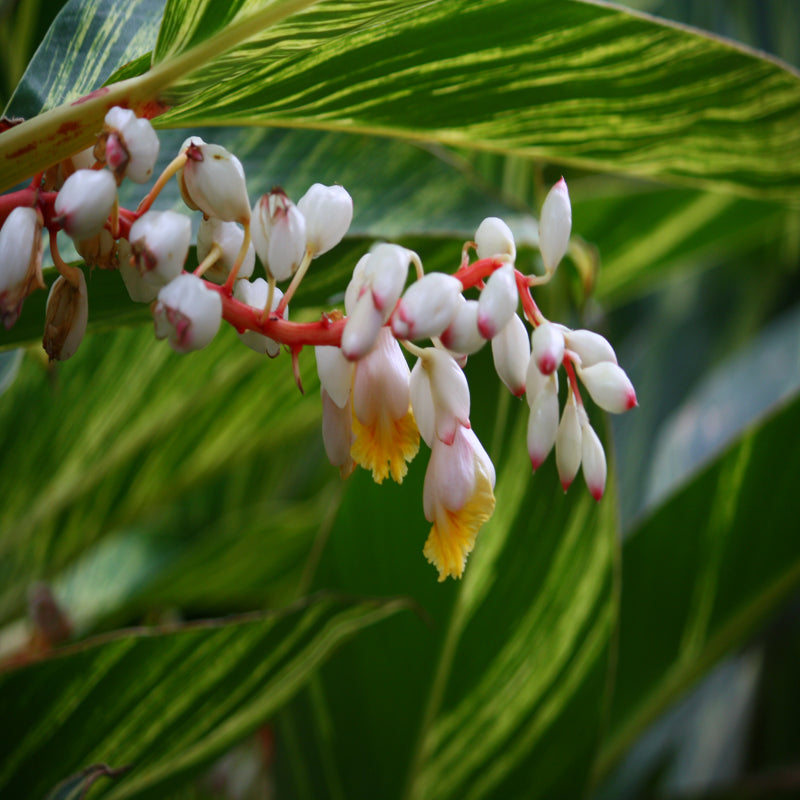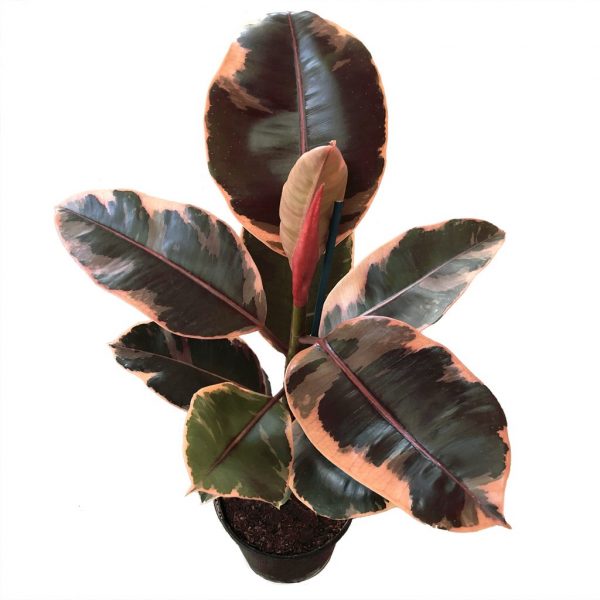The Alpinia Zerumbet ‘Variegata’ plant is a herbaceous perennial popular for its attractive foliage and flowers.
It belongs in the family of Zingiberaceae (the ginger family) along with Zingiber Officinale.
attractive alpinia zerumbet variegata plantPin
It is native to Eastern Asia, particularly open woodlands.
Its variegated cultivar is native to India.
The variegated shell ginger Alpinia is a year-round outdoor foliage plant when grown in its hardiness zone.
The synonyms of this plant are Alpinia Speciosa, Costus Zerumbet, and Languas Speciosa.
The common names include:
Variegated Shell Ginger
Shell Ginger
Indian Shell Flower
Pink Porcelain Lily
Butterfly Ginger
Variegated Ginger
Alpinia Zerumbet Variegata Plant Care
Size & Growth
Variegated ginger is a low maintenance plant featuring upright clumps with fleshy, dense rhizomes, resembling the culinary ginger.
This specimen plant with a rapid growth rate grows to about 10’ feet tall.
However, when grown as an annual container plant in northern areas, it only grows about 3’ to 4’ feet tall.
Long arching stems grow from the rhizomes with several lance-shaped leaves.
As the name suggests, this plant has variegated foliage.
It produces green leaves with yellow stripes.
However, each leaf varies in its variegation amount – some are green with gold or creamy yellow strips, and others are yellow with green-colored streaks.
Flowering and Fragrance
The Variegated Ginger produces inflorescence of shell-like flowers.
These are often referred to as shell flowers since the buds bear a resemblance to sea shells.
However, it is important to note these pink flowers don’t blossom on the plants being stored for winter or grown as annuals since it only produces inflorescences on old growth.
Variegated shell ginger flowerPin
This unique feature of this plant, making it different from other members of the ginger family, is the way the flower starts dropping instead of rising.
The flower color ranges from pink to white flowers and often turns bright red and yellow shades in the summer of the plant’s second year.
The typical bloom time of variegated ginger plants is the summer months.
The flowers have a slight fragrance. In rare cases, the flowers are followed by fruits.
Light & Temperature
The Shell Ginger enjoys growing in the full sun but likes afternoon shade during the harsh summers.
Even though it tolerates various light conditions, it is best to place the plant under a bright light.
Ideally, place the plant near a south-facing window when growing indoors where it receives part sun or filtered sun and is protected from the harsh rays of the midday sunshine.
The USDA zone of hardiness is from 8 to 10.
However, these plants might tolerate zone 7 when adequately protected during the winter season.
Variegated Shell Ginger Watering and Feeding
During its growing season, this plant requires plenty of water.
Avoid letting the soil dry out completely, but also ensure it is not soggy constantly.
It is not a drought-tolerant plant and will suffer greatly without proper irrigation, especially during the summer season.
Partial shade and regular watering will ensure the plant grows optimally.
If growing in containers, make sure to feed the plant every month with liquid food.
Peters Classic 20-20-20 All Purpose Fertilizer, 8-Ounce
Peters Classic 20-20-20 All Purpose Fertilizer, 8-OuncePin
Click to Learn More | Buy from Amazon
If you click this link and make a purchase, we earn a commission at no additional cost to you.
Soil & Transplanting
The Variegated Shell Ginger is not too picky about the potting mixture.
However, a well-draining and organically rich soil is recommended for growing this plant.
Provide the plant clay, loam, or sand mixture, which is slightly acidic.
Make sure whichever potting mixture you use doesn’t dry out as the variegated shell ginger requires moist soil surface.
You may improve the quality of the soil by adding organic compost.
Grooming and Maintenance
The houseplants grow optimal in humid conditions and under a bright light.
The lack of sufficient moisture, as well as harsh cold temperatures, may turn the edges of the leaves brown.
It is best to apply a layer of mulch around the roots to protect against cold.
How To Propagate Variegated Shell Ginger
The propagation of this plant is done using the division method.
Use a garden fork or shovel to dig out a clump and divide the rhizomes into multiple parts using your hands.
However, if the clump is too big, dig out a small section from the outer edge of the plant.
You may use the rhizomes both with and without shoots.
Use a rich soil mixture and add 2” to 4” inches of organic matter around it.
Plant the rhizomes at a similar soil depth as they were planted in the original spot.
Cover them properly with soil and water immediately.
Variegated Shell Ginger Plant Pest or Diseases
This plant doesn’t experience any significant disease or pest concerns.
However, it is wise to monitor the plant for spider mites and treat accordingly.
Alpinia Zerumbet Variegata Plant Uses
Alpinia variegata shell ginger is used to create a tropical effect in various types of gardens and landscape design, mainly for its stunning foliage even in full sun.
The shell ginger plant is also used as a houseplant, garden annual and looks excellent when planted in large containers and small groups.
It makes an eye-catching accent plant when placed by an entrance or used in a shrub border.








Reviews
There are no reviews yet.